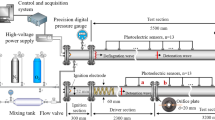Abstract
The possibility of using a high-voltage nanosecond discharge to initiate gaseous detonation was shown experimentally. The experiments were performed with C3H8 + 5O2 and C3H8/C4H10 + 5O2 + xN2 (x = 0–10) mixtures at an initial pressure of 0.15–0.6 atm. The discharge was initiated by a voltage pulse of duration ≈60 nsec and amplitude 4–70 kV; the energy input was 0.07–12 J. Under the conditions of the experiment, three flame propagation regimes were observed: slow combustion, transient detonation, and Chapman—Jouguet detonation. For the initiation of the C3H8+ 5O2 mixture in a tube of diameter 140 mm, the length of the deflagration to detonation transition was 130 mm at an initial pressure of 0.3 atm and an initiation energy of 70 mJ.
Similar content being viewed by others
References
J. E. Elsworth, P. J. Shuff, and A. Ungut, “‘Galloping’ gas detonations in the spherical mode,” in: J. R. Bowen et al., Progress in Astronautics and Aeronautics, Vol. 94: Dynamic of Shock Waves, Explosions, and Detonation (1984), pp. 130–150.
E. Schultz Wintenberger and J. E. Shepherd, “Investigation of deflagration to detonation transition for application to pulse detonation engine ignition systems,” in: Proc. of the 16th JANNAF Propulsion Symp., Chem. Propuls. Inform. Agency (1999).
C. J. Brown and G. O. Thomas, “Experimental studies of ignition and transition to detonation induced by the reflection and diffraction of shock waves,” Shock Waves, 10, 23–32 (2000).
R. Sorin, R. Zitoun, and D. Desbordes, “Optimisation of the deflagration to detonation transition: Reduction of length and time of transition,” in: 19th Int. Colloq. on Dynamics of Explosions and Reactive Systems (ICDERS), Hakone, Japan, July 17–August 1 (2003), Paper No. 142.
S. I. Jackson and J. E. Shepherd, “Initiation systems for pulse detonation,” in: 38th AIAA/ASME/SAE/ASEE Joint Propulsion Conference and Exhibit, Indianapolis, July 7–10 (2002); AIAA Paper 2002-2627.
J. E. Shepherd, J. M. Austin, T. Chao, et al., “Detonation initiation and propagation,” in: Abstr.of the 15th ONR Propulsion Conf., Washington, August (2002).
N. N. Smirnov and V. F. Nikulin, “Effect of channel geometry and mixture temperature on deflagration to detonation transition in gases,” Combust., Expl., Shock Waves, 40, No. 2, 186–189 (2004).
Ya. B. Zel’dovich, V. B. Librovich, G. M. Makhviladze, et al., “On the onset of detonation in a nonuniformly heated gas,” J. Appl. Mech. Tech. Phys., No. 2, 264 (1970).
A. Yu. Starikovskii, “Initiation of ignition by the action of a high-current pulsed discharge on a gas,” Combust., Expl., Shock Waves, 39, No. 6, 619–626 (2003).
S. M. Starikovskaia, N. B. Anikin, S. V. Pancheshnyi, et al., “Pulsed breakdown at high overvoltage: Development, propagation and energy branching,” Plasma Sources Sci. Technol., 10, 344–355 (2001).
J. H. Lee, R. Knystautas, and C. M. Guirao, “Critical power density for direct initiation of unconfined gaseous detonations,” in: 15th Symp. (Int.) on Combustion, Combustion Inst., Pittsburgh (1974), p. 53.
J. B. Liu, P. D. Ronney, and M. A. Gundersen, “Premixed flame ignition by transient plasma discharges,” in: Abstr. of the Twenty-Ninth Int. Symp. on Combustion, Sapporo, Jpn, July 21–26 (2002).
F. Wang, C. Jiang, A. Kuthi, et al., “Transient plasma ignition of hydrocarbon—air mixtures in pulse detonation engines,” in: 42nd AIAA Aerospace Sciences Meeting and Exhibit, Reno, NV, January 5–8 (2004); AIAA Paper 2004-834.
S. A. Bozhenkov, S. M. Starikovskaya, and A. Yu. Starikovskii, “Nanosecond gas discharge ignition of H2-and CH4-containing mixtures,” Combust. Flame, 133, 133–146 (2003).
S. M. Starikovskaya, E. N. Kukaev, A. Yu. Kuksin, et al., “Analysis of the spatial uniformity of the combustion of a gaseous mixture initiated by a nanosecond discharge,” Combust. Flame, 139, 177–187 (2004).
A. Yu. Starikovskii, “Deflagration-to-detonation control by non-equilibrium gas discharges and its applications for pulsed detonation engine,” in: Abstr. of the 39th AIAA Joint Propulsion Conference and Exhibit (2003); AIAA Paper 2003-4686.
M. Beyer, W. Boeck, K. Möller, and W. Zaengl, Hochspannungstechnik, Theoretische und Praktische Grundlagen, Springer-Verlag (1986).
N. Lamoureux, C. E. Paillard, and V. Vaslier, “Low hydrocarbon mixtures ignition delay times investigation behind reflected shock waves,” Shock Waves, 11, 309–322 (2002).
Author information
Authors and Affiliations
Additional information
__________
Translated from Fizika Goreniya i Vzryva, Vol. 42, No. 2, pp. 80–90, March–April, 2006.
Rights and permissions
About this article
Cite this article
Zhukov, V.P., Starikovskii, A.Y. Effect of a nanosecond gas discharge on deflagration to detonation transition. Combust Explos Shock Waves 42, 195–204 (2006). https://doi.org/10.1007/s10573-006-0038-2
Received:
Revised:
Issue Date:
DOI: https://doi.org/10.1007/s10573-006-0038-2



